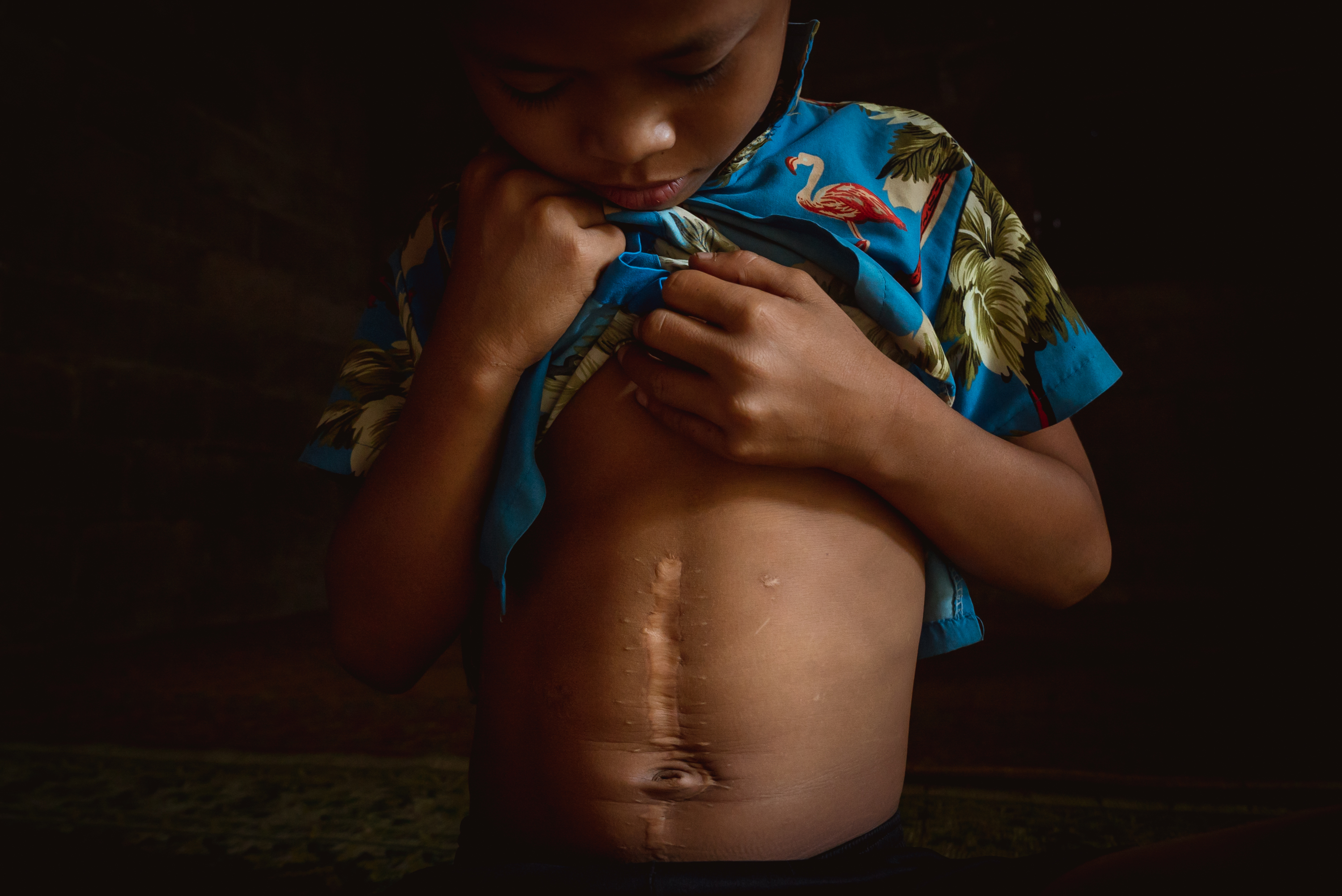On average, one person is killed or injured by landmines and other explosive ordnance every hour
Landmines kill in seconds, their fallout lasts generations
April 3, 2024

A child in Lao PDR showing a scar from a wound caused by unexploded ordnance.
It was an ordinary day that turned into tragedy. Sone was walking home with her young boy in their village in Lao PDR. They had been buying biscuits in the local shop. Hand in hand, they saw a large cloud of smoke. She ran home to find the house in flames and her husband dead. A bomb dropped almost 50 years ago that he had collected as scrap metal had exploded.
Overnight, Sone became the family breadwinner. Her daughter dropped out of school to help. When they found more unexploded ordnance in their field, clearance operations meant her entire cassava crop would have to be uprooted. She waited until after the harvest. She says that starvation was a bigger threat than the bombs. “My children are still young, and I needed money to feed my family,” she says.
In Viet Nam, Nguyen watched every year as her house was flooded. Her family lived in the lowlands because the hills remained contaminated by explosives 50 years after the end of the Second Indochina War. “I had to take my belongings, children, and the cow to friends or family until the flooding passed,” she says.
Millions of people like Sone and Nguyen are forced into the difficult position of taking risks to survive. UNDP has worked with the Government of Viet Nam clear 9,000 hectares of land in Nguyen’s area so she has been able to relocate. In Lao PDR, UNDP has helped villages like Sone’s by working with local institutions on surveying, clearance, risk education and victim assistance. As of March 2024, over 1.9 million pieces of unexploded ordnance have been destroyed in the country.
Clearing a path for development, one landmine at a time
On average, one person is killed or injured by landmines and other explosive ordnance every hour. Their destructive influence lasts long after armed conflict ends, inflicting horrific injuries and death, while trapping communities in poverty and fear. Millions of people are being put in harm’s way as conflict proliferates - from Afghanistan to Myanmar, to Sudan, to Ukraine, to Colombia, and to Gaza.
Ukraine is the second largest country in Europe. A third of its territory needs to be surveyed as it is at risk of contamination. Fertile lands have been put beyond use, undermining the world’s food security. Clearing the country will take decades, if not generations. Ensuring farms are safe is a priority.
Paul Heslop, the UNDP Mine Action Programme Chief Technical Advisor in Ukraine puts it like this: “If a litre of fuel is a cent or two cents more than it should be, or if a loaf of bread is ten cents more than it would be because of Ukraine, the economic impact of what we are doing is huge. Me not doing my job right in Kyiv could mean kids starving in Somalia or Afghanistan.”
By utilizing artificial intelligence, aerial imagery and well-equipped demining teams, UNDP has helped the State Emergency Service of Ukraine show that 21,000 square kilometres of possibly contaminated land have no evidence of mines. The innovations can reduce costs for non-technical surveys from US$200 million to $50 million in Ukraine, and the technology can be used in other countries.
Protecting lives, building peace
There are solutions to the global mine and explosive problem. The Anti-Personnel Mine Ban Convention came into force 25 years ago, on 1 March 1999. Since then 164 states have ratified it, 55 million stockpiled mines have been destroyed, 30 countries have been declared clear of mines, and casualties have dropped from 25,000 people in 1999 to below 5,000 people last year.
Mine action has saved millions of lives through clearance and education, helped survivors rebuild their future and opened up pathways to peace. For UNDP, it is a precondition for its development initiatives to be undertaken safely. Since its mine action began, and over the past three decades, UNDP has helped governments tackle the challenges posed by explosive ordnance in more than 50 countries.
The theme of this year’s International Day for Mine Awareness and Assistance in Mine Action on 4 April is “Protecting Lives, Building Peace”. A newly adopted United Nations Mine Action Strategy offers hope for all victims of landmines and for communities living at risk. It needs resourcing from donors. And those 30 states who have not yet must ratified Anti-Personnel Mine Ban Convention must do so.

 Locations
Locations